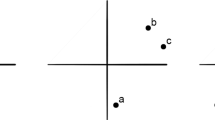Abstract
Five fundamental manifestations of symmetry in physics—reproducibility as symmetry, predictability as symmetry, symmetry of evolution of isolated physical systems, symmetry of states of physical systems, and gauge symmetry—are investigated for their essential meaning and physical significance. The approach is conceptual, to the complete exclusion of mathematical formalism.
Similar content being viewed by others
References
J. Rosen,A Symmetry Primer for Scientists (Wiley, New York, 1983).
J. Rosen,Symmetry Discovered: Concepts and Applications in Nature and Science (Cambridge University Press, Cambridge, 1975), Chap. 4.
W. B. Jensen, “Classification, symmetry and the periodic table,” Comput. Math. Appl.128, 487–510 (1986), reprinted inSymmetry, Unifying Human Understanding, I. Hargittai, ed. (Pergamon, New York, 1986), pp. 487–510.
J. N. Shive and R. L. Weber,Similarities in Physics (Wiley, New York, 1982).
J. Rosen, “The anthropic principle,”Am. J. Phys. 53, 335–339 (1985).
J. Rosen, “The anthropic principle II,”Am. J. Phys. 56, 415–419 (1988).
J. Rosen, “Symmetry at the foundations of science,” Comput. Math. Appl.17, 13–15 (1989), reprinted inSymmetry 2, Unifying Human Understanding, I. Hargittai, ed. (Pergamon, New York, 1989), pp. 13–15.
J. Rosen, “Symmetry in the structure of science,” Proc. 1st Interdisciplinary Symposium on the Symmetry of Structure, Budapest, 1989.
R. M. F. Houtappel, H. Van Dam, and E. P. Wigner, “The conceptual basis and use of the geometric invariance principles,”Rev. Mod. Phys. 37, 595–632 (1965).
J. Rosen and Y. Freundlich, “Symmetry and conservation,”Am. J. Phys. 46, 1030–1041 (1978), reprinted inSymmetry in Physics, J. Rosen, ed. (American Association of Physics Teachers, Stony Brook, 1982), pp. 135–146; note the sequel, J. Rosen, “Symmetry and conservation: Inverse Noether's theorem and general formalism,”J. Phys. A 13, 803–813 (1980).
J. Rosen, “Extended Mach principle,”Am. J. Phys. 49, 258–264 (1981).
J. Rosen,A Symmetry Primer for Scientists (Wiley, New York, 1983), Chap. 6.
J. Rosen,A Symmetry Primer for Scientists (Wiley, New York, 1983), Chap. 5.
I. J. R. Aitchison and A. J. G. Hey,Gauge Theories in Particle Physics (Hilger, Bristol, 1982).
D. Griffiths,Introduction to Elementary Particles (Wiley, New York, 1987), Chap. 11.
R. Mills, “Gauge fields,”Am. J. Phys. 57, 493–507 (1989).
M. Carmeli,Classical Fields: General Relativity and Gauge Theory (Wiley, New York, 1982).
H. Poincaré,Science and Hypothesis (Dover, New York, 1952), Chap. 4.
H. Sokolik and J. Rosen, “Algebraic interpretation of the Yang-Mills field,”Gen. Relativ. Gravit. 14, 707–711 (1982).
Author information
Authors and Affiliations
Rights and permissions
About this article
Cite this article
Rosen, J. Fundamental manifestations of symmetry in physics. Found Phys 20, 283–307 (1990). https://doi.org/10.1007/BF00731694
Received:
Revised:
Issue Date:
DOI: https://doi.org/10.1007/BF00731694




